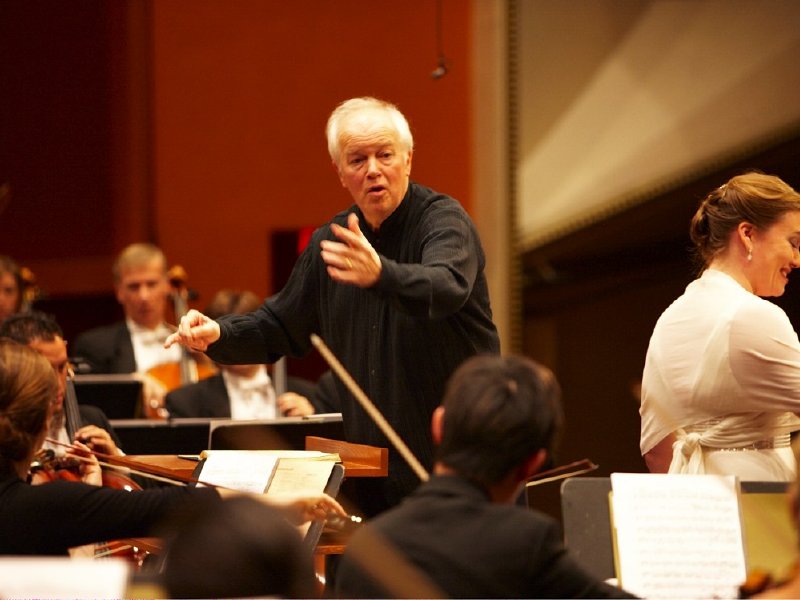Worshipping At the Altar of Mahler
De Waart and the MSO take on Mahler’s 9th, leaving some players with tears in their eyes.
Maybe going to hear a Mahler symphony live isn’t the test of patience it used to be. The entertainment juggernauts of our time are certainly approaching or surpassing Mahlerian, even Wagnerian, lengths. On the night I attended this concert, millions of people across the country were packing into movie theaters to sit through Avengers: Endgame, which clocks in at just over three hours, and the last four episodes of the final season of “Game of Thrones” are said to hover around 80 minutes each. Truth be told, the 80-minute symphony I heard tonight flew by in what felt like 40 minutes, despite its time-expanding elements (more on that later). Whether you choose to worship at the altar of music, cinema or television, the length is no problem when you want the most epic, life-altering experience possible.
My perception of time, or of any quality of this performance, might be biased by one key fact: I was sitting in the second row, directly behind Maestro Edo de Waart. It was maybe the closest I’ve ever sat at a professional orchestra concert, and it just happened to be at a performance of Mahler’s Ninth. Gustav Mahler, the one who said that a symphony should “contain the whole world,” who struggled with the fabled “curse of the Ninth” (Beethoven’s own Ninth Symphony being so intimidating that several composers almost couldn’t finish their own without dying shortly after), whose Ninth itself is kind of a huge meditation on death and existence. And here this music was conducted by De Waart, as part of a prolonged farewell to the orchestra he has led for 10 years. So much inherent drama!
The second movement has always sounded to me like a summary of Mahler’s other folky, dancelike scherzos, at least in the opening. But then it gets weird. The orchestra ably navigated these different tempo areas and moods. The highlight was a super fast 3/4 dance section with shrieking accented violins (led with gusto by Frank Almond), with great support from the low brass. In my notes I wrote here “the orchestra sounds world-class,” though this statement could apply to many other parts of the performance. Sequences of woodwind groups at the close of this movement were extremely fine.
This symphony has the same movement-order disorientation of Tchaikovsky’s “Pathétique,” which I reviewed a few weeks ago; the third movement feels like the action-packed finale, but then there’s more to come. The ensemble was top-notch during the sort of contrapuntal concerto for orchestra that opened the third movement. Everything lined up. John Williams must be a fan of this movement; hearing this again for the first time in a while, I noticed phrases that were echoed in both the scores of E.T. and the “March of the Resistance” from Star Wars Episode VII.
The final Adagio brought all of the drama together. This is music that unspools gorgeous, world-weary slow melodies for twenty-something minutes, finally winding down into quiet sighing gestures that grow further and further apart (often interpreted as Mahler evoking his own unsteady heartbeat). It feels like it goes on forever, and at the same time you don’t want it to end. You could set this music to a montage of humanity’s greatest tragedies and struggles, or even just a highlight reel of someone’s own life while they lie on their deathbed. The strings delivered a supremely touching opening paragraph but soon surpassed themselves with each new entrance. Maestro de Waart gestured to his heart several times and made that hand-shaking “more emotion” sign. From my seat in the second row, I realized why conductors are drawn to this piece, especially in the twilight of age. You’re enveloped in this beautiful sound, and it becomes intensely personal; the musicians are playing for you. And as the full orchestra swells, you realize that they’ve all been wearing black this whole time, as if dressed for your funeral. Indeed, as a musician, conducting this music is probably the closest you can get to attending your own funeral. In Maestro de Waart’s position, I’d probably feel like I was floating above the stage, leaving the earthbound players behind.
The last four minutes or so were astonishing in their cosmic vastness, and I hung on every fragile gesture from the instruments. When Maestro de Waart finally laid down his baton, I was moved by the sight of these musicians, closer than I’d ever seen them onstage, still feeling the effects of this music, some with tears in their eyes.
Leonard Bernstein described this symphony as Mahler’s statement on not only individual death, but also the death of society and even the death of Faustian (western) culture, by which I think he meant the end of the whole Romantic era in art and the impending death of tonality. Today, this beautiful, terrifying, otherworldly piece is ready for you to project all sorts of thoughts and feelings into it. It’s music for the end of life, and music for the end of the world.
Review
-
New Musical a Life and Death Comedy
![Stephanie Beschta [Mrs. McCobb] and Shayne Patrick [Mr. McCobb] in RIP – A Matter of Life and Death. Photo by Stacy Kaat (www.stacykaat.com).](https://urbanmilwaukee.com/wp-content/uploads/2024/07/WEB-6056-185x122.jpg) Jul 19th, 2024 by Dominique Paul Noth
Jul 19th, 2024 by Dominique Paul Noth
-
Ouzo Café Is Classic Greek Fare
 May 23rd, 2024 by Cari Taylor-Carlson
May 23rd, 2024 by Cari Taylor-Carlson
-
‘The Treasurer’ a Darkly Funny Family Play
 Apr 29th, 2024 by Dominique Paul Noth
Apr 29th, 2024 by Dominique Paul Noth






















This is the very model of a fine music review. Informed, detailed, and written with affection for the music under consideration. Bravo Brendan Fox!